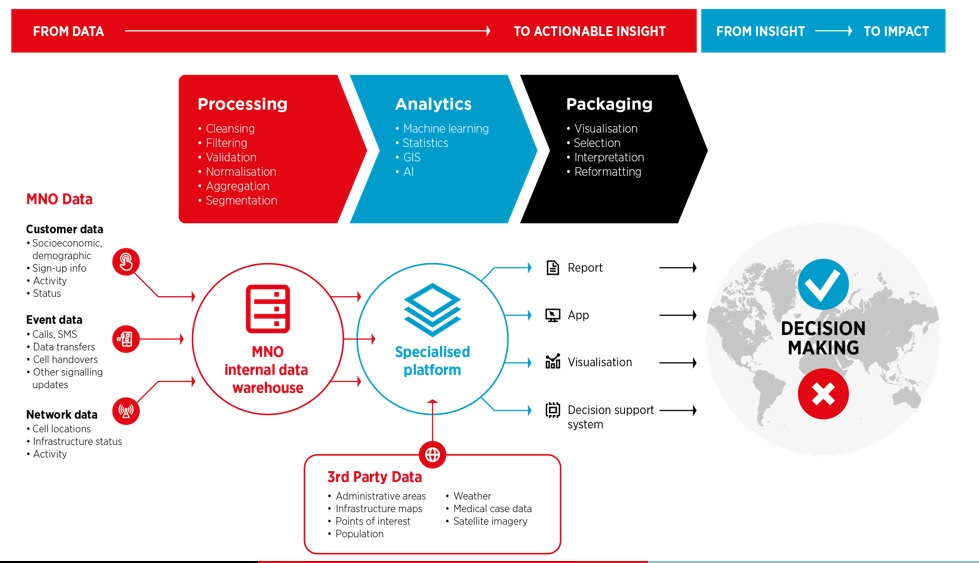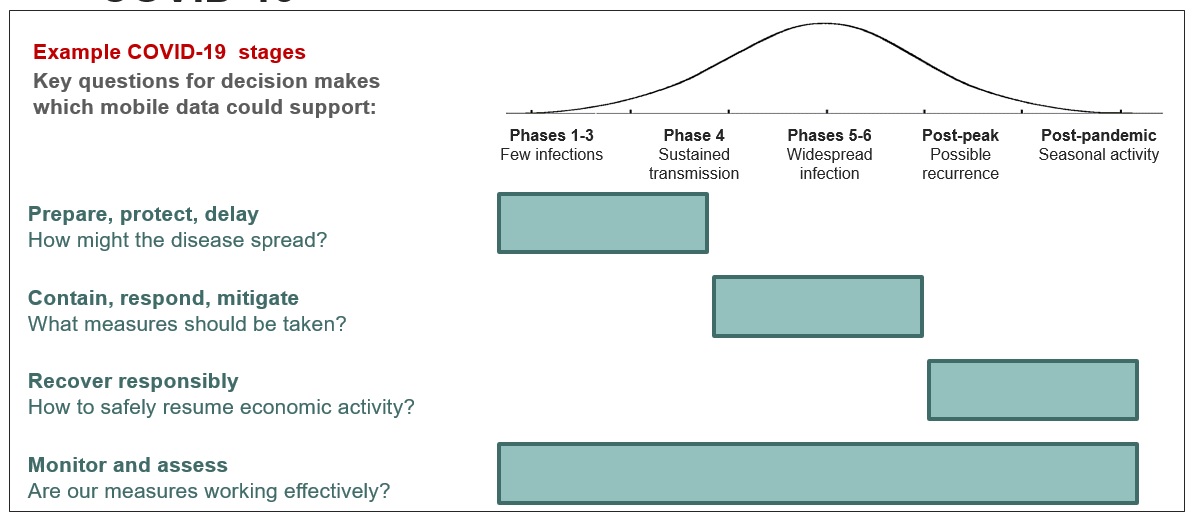Mobile networks and communication play a central role in the lives of people around the world. Because the technology is so pivotal and integrated into daily behaviours, the dashboards, reports and decision making tools that mobile operators are now developing can reveal valuable insights that can’t be obtained from other sources. Generating these insights accurately and responsibly takes expertise and care, but if done correctly it can improve decision making and save lives.
In this blog we will briefly cover the fundamental technical considerations for operators moving ‘from data to actionable insight’, before exploring some of the ways these decision making tools can be used to inform the COVID-19 response of governments and public health agencies, moving ‘from insight to impact’. For a more comprehensive view on these topics we invite you to join the next webinar, ‘Mobile Big Data Analytics – Technical delivery and adoption’, taking place on Thursday, 27 August. Register here.
How are mobile operators able to move ‘from data to actionable insights’?
Insights are processed, meaningful outputs that are extracted from the underlying raw data to address specific questions. There are a number of preparatory steps required to produce actionable insights from raw data, as illustrated in the diagram below. AI4I has broken these steps down into 3 main stages: Processing, Analytics, and Packaging. It should be noted that each of these stages are conducted within MNOs’ systems in accordance with local laws, and the insights shared are based on aggregated, anonymised data, to ensure customer privacy is protected.

As a starting point, there are broadly three types of mobile data relevant to generating impactful insights:
- Customer data – fairly static data about customers, mainly used for customer relationship management (CRM) within the MNO
- Event data – fast-moving data about interactions between customers and the network. Each event relates a SIM card to a cell tower or base station at a point in time.
- Network data – data about the network itself, such as the locations of towers, their operational status and levels of activity.
Further detail on the above can be found in the AI4I Digital Toolkit.
Mobile data fits the well-known definition of “big data” based on “four v’s”: volume, velocity, variety and veracity. Another key characteristic of this data is that it is organic – generated without the express purpose of data collection, as the records fulfil essential functions in the network like call routing and billing. Given these properties, mobile operators still need to undertake the following steps for insights to be realised:
Stage 1: Processing
Like all real-world big data sets, mobile big data is noisy. Cleansing, filtering, and validating are performed in the processing phase. These steps involve removing irrelevant or erroneous entries, which can arise from many sources. This requires care and expertise, and detailed knowledge of the customer base and the network systems that generate the data. Neglecting or mishandling this stage will produce inaccurate results.
Stage 2: Analytics
The cleansed and processed data is combined with other sources and subjected to analysis around specific research questions or objectives. The specifics of this stage are heavily dependent on the project and the desired outcomes, but it will almost certainly involve data from other, non-mobile sources, such as satellite or survey data, population or infrastructure maps, and the application of one or more specialised tools and techniques, such as geographical information systems (GIS), machine learning or statistical analysis. The expertise for this phase may sit within operators, demand-side agencies, governments or third parties.
Stage 3: Packaging
The results need to be compiled into a useable format so they can be incorporated into existing decision making processes. This might be a one-off report, a set of visualisations, an app or dashboard, or a fully-fledged decision support system. All of these options use and present aggregated, anonymous insights, with all personal data and individual behaviours completely protected.
Dashboards are commonly used to present critical information to health authorities and other decision makers. Reports and visualisations, generated on a regular, pre-determined schedule are a common way of circulating the most pertinent headlines to a wider audience. In some cases, operators have the resources or work with knowledge partners to conduct epidemiological modelling, using their mobility insights as a key input, and make predictions about the spread of the disease under various scenarios which can then be planned for.
Find more detail on these stages in the AI4I toolkit’s Technical Considerations paper.
How can these insights deliver impact in response to COVID-19, and future pandemics?

Governments are continuing to make critical, time sensitive decisions as the COVID-19 pandemic evolves. The above diagram illustrates, at a high level, the most critical questions at each phase of the pandemic. Mobile big data insights have a role to play in helping to answer all of these questions, realising the final step from ‘insight to impact’. Expanded information and material will be covered in the next GSMA webinar ‘Mobile Big Data Analytics – Technical delivery and adoption’, took place on Thursday, 27 August. Watch the video highlights here.
Where can I learn more about the use of mobile big data analytics?
The AI4I Webinar Series, ‘Using mobile big data analytics to combat challenges including COVID-19’, provides a platform for a deeper level of understanding for mobile operators and governments who wish to develop and adopt impactful products and services to aid decision making.
Watch the series video highlights:
Webinar 1: Overview of Mobile Big Data Analytics to combat challenges including COVID-19
Webinar 2: Mobile Big Data Analytics – Privacy & Policy Considerations
Read related blog posts:
Overview of Mobile Big Data Analytics to combat challenges including COVID-19
Mobile Big Data Analytics – Privacy & Policy Considerations
More information about AI4I and technical delivery and adoption considerations for solutions can be found in the GSMA AI4I digital toolkit.